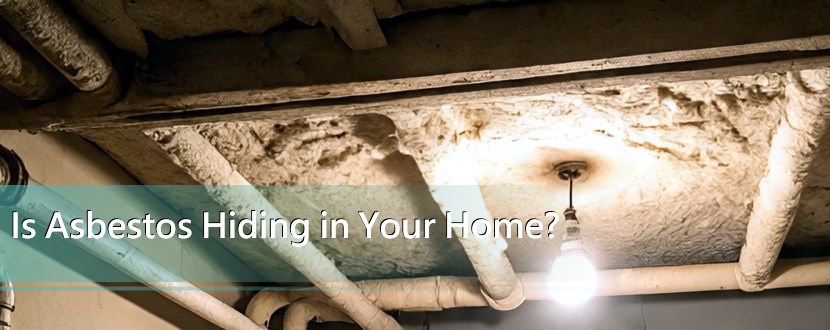Where asbestos hides in older homes – a practical guide

Is Asbestos Hiding in Your Home? 7 Common Places You Should Check Today
Let’s be honest, most of us don’t think about asbestos until someone mentions it. Maybe you heard a neighbor talking about a renovation gone wrong. Or you saw a contractor in a hazmat suit on the next block. Suddenly, it’s on your mind. And now you’re wondering: could it be in my house too? The answer, especially if your home was built before the 1980s, is maybe. Not definitely. But maybe enough that you should take a closer look.
Why this isn’t just an old wives’ tale
Asbestos was everywhere once. Builders loved it. Fireproof, durable, cheap. You’d find it tucked into insulation, wrapped around pipes, pressed into floor tiles. Then the lawsuits started. The coughing. The diagnoses. The slow realization that what kept houses safe from fire could slowly wreck human lungs. Regulations came. Bans followed. But no one went back and ripped it out of every wall. So it stayed. Quiet. Invisible. Waiting.
And here’s the thing, it’s not dangerous if it’s left alone. Intact. Sealed. Undisturbed. The trouble starts when you sand it, drill into it, or rip it out without knowing. That’s when fibers get loose. That’s when they float. That’s when someone breathes them in.
Attic insulation – the fluffy suspect
Go up into your attic. Take a look. If you see loose, fluffy stuff that looks a little like candy floss but smells like dust and regret—that might be vermiculite. A lot of it came from a mine in Libby, Montana, and guess what? That mine was contaminated with asbestos. If your insulation is grayish-brown or silver-gold and poured in like lumpy oatmeal, don’t touch it. Don’t stir it up. Just close the hatch and call someone who knows what they’re doing.
Popcorn ceilings – not as fun as they sound
Remember those bumpy ceilings from the 70s? The ones that looked like someone had sprayed spray foam all over the room? Yeah. A lot of those were finished with asbestos-containing texture. Scraping them off seemed like a good idea—until people started getting sick. If you’ve got one, and it’s not crumbling, you’re probably fine. But if you’re planning to knock it down or sand it smooth? Stop. Test it first. Seriously.
Vinyl floor tiles – the silent floor dwellers
Those 9x9-inch tiles in your kitchen or basement? The ones that look indestructible? They might be. And that’s the problem. Asbestos was mixed into the backing and adhesive to make them last. If they’re intact, no big deal. But if you’re ripping them up to install new flooring, you could be stirring up trouble. Even the glue underneath—black mastic—can be loaded with it. Don’t go at it with a heat gun or scraper until you’re sure.
Hot water pipes – wrapped in danger
Head to your basement. Look at the pipes. See that white or gray wrapping around them? Looks a bit like a mummy’s bandage? That’s pipe insulation. And if your house is pre-1980, there’s a solid chance it’s laced with asbestos. It was great at keeping heat in. Terrible at keeping fibers out once it starts to crack. If it’s crumbling or you’re planning to re-pipe, get it tested. Don’t wing it.
Roofing and siding – the outside threats
Asbestos wasn’t just indoors. It got mixed into cement shingles, roofing felt, and even siding panels. Why? Because it didn’t rot. Didn’t burn. Held up to the weather. If you’re replacing your roof or scraping old siding, don’t assume it’s safe just because it’s outside. Fibers don’t care if they’re released in your attic or your backyard. They’ll still find a way into someone’s lungs.
Old appliances – the forgotten culprits
This one surprises people. Your ancient oven? The one with the push-button timer and the weird dial that never worked right? Some of those had asbestos insulation behind the panels. Same with old space heaters, toasters, even hair dryers. Most are long gone. But if you’ve got a vintage appliance you’re restoring—or worse, still using—it’s worth a second look, especially if you’re taking it apart.
What to do if you find it—or even suspect it
First, don’t panic. Asbestos isn’t like mold or radon. It doesn’t seep or spread on its own. If it’s sealed, painted over, or otherwise undisturbed, you’re not in immediate danger. But don’t ignore it either. Don’t poke it. Don’t sand it. Don’t “see what’s under there.”
Call a licensed asbestos inspector. They’ll take samples. Send them to a lab. Tell you what you’re dealing with. If it needs to come out, hire an abatement professional. Yes, it costs money. Yes, it’s a hassle. But compared to the alternative? Worth every penny.
And if you’re buying an older home? Make asbestos testing part of your inspection. Don’t let the inspector skip it because “it’s probably fine.” You wouldn’t skip checking the foundation. Don’t skip this.
A final thought that isn’t a sales pitch
I’ve seen too many people shrug this off. “My house is old, but I’m fine.” “My dad lived here 40 years and never got sick.” That’s luck. Not safety. Asbestos-related diseases can take decades to show up. By the time you cough, it’s too late to go back and fix what you disturbed ten years ago.
This isn’t fearmongering. It’s just physics and biology. Tiny fibers. Lungs that can’t clear them. Time that doesn’t forgive. You don’t need to tear your house apart. You just need to know what’s there. And act before you accidentally make it airborne.
So take a walk through your house this weekend. Look at the ceilings. Peek under floorboards. Glance at pipes. If something looks suspect, don’t guess. Test it. It’s one of those rare cases where knowing really is better than wondering.
Get Your Home Tested – Friendly Form Here